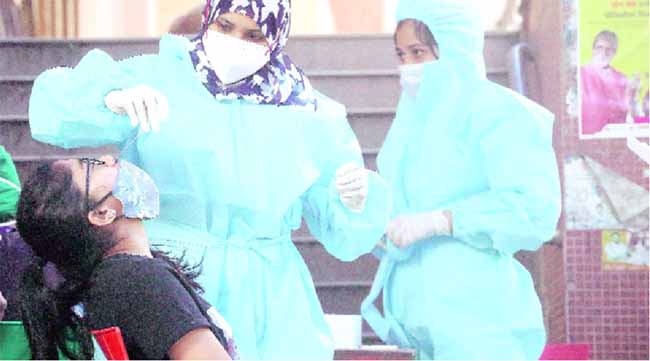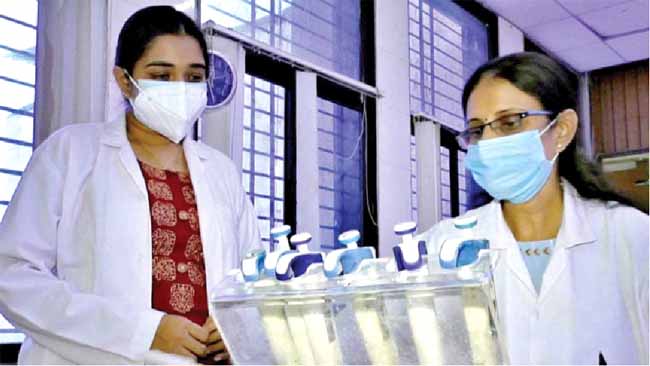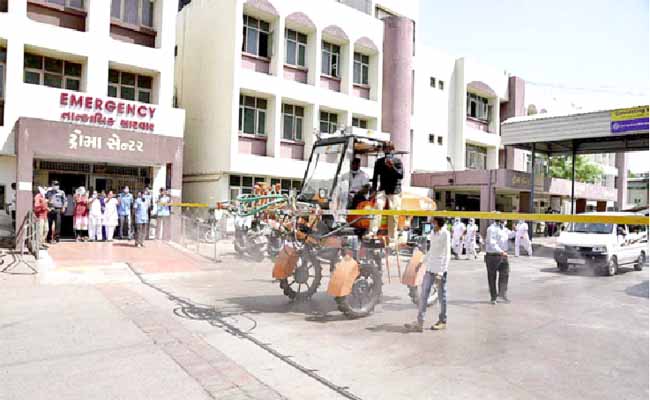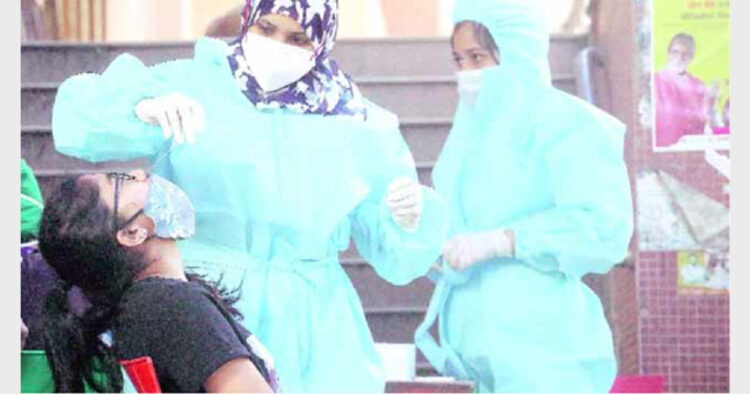Surat, the Diamond City of Gujarat, demonstrated its tenacity and ingenuity to mitigate the impact of COVID-19. The Surat Municipal Corporation played a productive role in tiding over the second wave. This success formula needs to be emulated by other cities

Surat was in national media headlines for all the wrong reasons just a month back. The headlines were full with lanes of ambulances with covid patients waiting for admission outside hospitals. Dead bodies waiting for hours to be cremated outside the Shamshan Gruhs. Shortage of beds, shortage of Remdesivir injections, shortage of oxygen etc. Yes, that was the scenario for almost ten days when the second wave of covid hit Surat in mid-April. Today at the end of May Surat is calm and cooling down the impact of the second wave. Case Positivity Rate Down to 0.52%; Without lockdown or curbs; infections reducing. Diamond City has once again shown the power of its inherent resilience by taming the second wave of Coronavirus that has surged monstrously.
The Surat Municipal Corporation (SMC) embraced the mantra of ‘Triple T-IQ strategy (Track, Test, Treat, Isolate and Quarantine) which helped tide over the first wave. The same strategy was made more aggressive when the second wave started. Well defined Standard Operating Procedures (SOPs) developed during the first wave helped the city in combating the second wave more effectively. Surat houses a population of nearly 70 lakhs. Flourishing diamond and textile industry that employs lakhs of migrants, the challenge was to ensure people get timely tests and quality and affordable treatment.
But the main task was to ensure all this was done without imposing debilitating lockdowns and avoid the bitter repeat of the massive migrant exodus of last year. A well-planned and systematically executed pandemic management strategy ensured there was no undue suffering for the common man. This included aggressive tracing and surveillance using technology, active-passive surveillance, scientific forecast model, aggressive testing, strict containment zones management and combing operations to find out every possible infected person.

Women warriors in Surat take charge of RT-PCR test
Augmentation of RT-PCR Capacity
RT-PCR testing was increased manyfold from the second week of March- from 1,500 tests a day to 8,500, which was the highest capacity. After aggressive tracing, SMC took up rigorous testing not just in the city but also at all entry and exit points, five check-posts, airport, railway stations and bus stops. In all, 1618 cases were detected at the railway station where 2,34,277passengers were screened. Similarly, 1075 positive cases surfaced during testing of 1,19,164 people at bus stations. At the five check-posts, 1,17,140 people were screened in one month (March 21-April 21) which helped to detect 4855 positive cases. A total of 83,654 health cards have been distributed, weekly tests carried out to reduce the infection generated from super spreaders.
To combat COVID-19, SMC formed a special task force team comprising Class – 1 officers of SMC and State Government. Each member was given responsibility to look after a specific task which caters to: –
Identification and Isolation of Patients
Testing in the diamond and textile industries, implementation of Covid appropriate behaviour in industries and mask distribution to workers were other measures. Surveillance, both active and passive, has been the key to reduction in cases in Surat. Average, 3.2 lakh houses were surveyed daily by engaging 2,478 teams in CPX-R (C –Covid like Symptoms, P – Presence of comorbid or above 50 years individuals, X – House Closed, R – Refusal for cooperation) surveillance strategy in all vulnerable areas and containment zones. This helped rapid identification and isolation of patients having Covid symptoms.
Passive surveillance was done through SMC’s model software called Jaimini application for all those having COVID-19 like symptoms and comorbidities. Surat is probably the only city in the country to collect details of patients having Acute Respiratory Illness from private hospitals and clinics using this application. Another important step in curbing the spread of the virus has been isolating areas witnessing a spike in positive cases by declaring them as containment zones. In all, 2113 containment zones were created and strict vigil was maintained by joint enforcement teams of SMC and Surat city police.
Fighting a pandemic of this scale is not possible without active participation of people and local communities. Swachh Suraksha Kavach Samitis were formed to bring out awareness and behavioural change among people by their community members in containment zones. The samiti comprises a doctor or paramedical staff, president/secretary of a residential society, school teacher, student, recovered COVID-19 patients, women, youngsters and members of NGOS and welfare groups. So far, a total of 8,890 such committees with 18,000 volunteers working actively which includes 5,879 in industrial areas alone where representatives of administration or the HR department of units are also involved.

Surat Municipal Corporation has a solid strategy to lessen the impact of the pandemic
In a bid to fight the coronavirus spread on a war-footing, SMC is using the Integrated Command and Control Centre set up under Smart City Mission in Vesu. A war room to carry out CCTV surveillance of public spaces and containment clusters along with mobile application to track the movement of quarantined people on real-time basis. A total of 745 doctors and 1098 para-medical staff are engaged in these 24X7 war rooms which have also been set up in all zones. War rooms have played a crucial role in mapping and management of responses.
Surat Municipal Corporation ensured that critical information like real-time bed availability, schedule / TPM of Dhanvantari Raths for testing and treatment related to Covid-19, information related to containment zones, daily positive cases, Various important notifications/guidelines/press release, etc are published on Surat Municipal Corporation’s Web Portal having dedicated Covid-19 Dashboard. SMC is one of the flag bearers in adoption of technology and was the first city who developed its monitoring and tracking app for effective implementation of quarantine and isolation of patients/suspects. It has various features including COVID-19 patient management and vaccination management. SMC also utilised technology for Hot Spot Analysis and used the same for containment planning, placement of Dhavantari Raths.
Some of the technology interventions taken by SMC included SMC Covid Tracker for quarantine, isolation and patient management, georeferencing to identify cluster formation and for micro containment planning and surveillance, Jaimini application to collect positive patient and ARI patient data from more than 2000 private hospitals and clinics, toll-Free Number, : SMC was the first to start dedicated Covid-19 helpline citizens to answer their question and Call Centre for travelers and migrant labourers. SMC set up a core team for planning and implementation of various strategies and analysing the trend and current situation in the entire city through “War room, SMC Epidemic Control, Vesu”.
Testing, Tracking Dhanvantari Rath Surat Municipal Corporation has ensured 365 days doorstep diagnosis and testing facility by Dhanvantari Raths which is a single focal point of TTT-IQ strategy in addition to 76 static testing centres across the city. More than 239 Dhanvantari Raths (mobile medical vans) that are equipped to carry out rapid antigen testing, ARI patients’ management, prophylaxis, SPO2 measurement etc, have been operationalized in Covid-hit areas. These vans too have been deployed using proper technology mapping and their daily TPM (Time Place Movement) has been published on SMC’s website so that maximum citizens can take benefit of this service. Approximately 18.65 lakh people are tested since March 1. Of these, 14,342 positive cases were detected.
Management of Oxygen supply was done on a real-time basis by forming three teams for government, private hospitals and CCICs. Uninterrupted oxygen supply was possible by tracking, coordination with Police and creating a reserve for any contingency. Real-time oxygen management and oxygen audit helped to rationalize the use. SMC formed a special audit team to carry out the audit of oxygen consumption not only in Government hospitals but also in Private Hospitals. These helped SMC in effective utilization of Oxygen at the hospitals. Since the oxygen demand was one of the critical requirements across the country during second wave, this initiative has helped SMC to ensure effective usage of oxygen. SMC ensured a continuous supply of oxygen to all government and private hospitals so that no patient was required to be transferred due to lack of oxygen supply.
SMC pioneered and introduced a unique concept of Community Covid Isolation Centres (CCIC), where various communities joined hands with SMC and started CCIC in various Community Halls. Total 34 CCICs were established with highly qualified doctors and medical staff, recreation activities to treat the patients. These centres provided the treatment at free of cost. These CCICs catered to the patients not only from Surat but also from other parts of Gujarat and other states. These centres proved lifesavers for number of patients and families who did not have proper quarantine and isolation facilities at the homes. Approximately 1606 beds out of which 572 were equipped with oxygen facilities were established in 34 CCICs. So far, 3258 patients have been treated successfully in these centres. These centres have reduced significant burden of mild patients on government and private hospitals.
Novel Use of Vaccination
Nearly 11 lakh people have been given the first dose. To encourage people, city and BRT buses were pressed into service for pick-up and drop from home for citizens. Ward-wise vaccination commanders were given the task of coordinating with vaccination centres and these efforts were supplemented by the Suraksha Kavach Samitis. Using this aggressive and systematic strategy, cases are fast declining within a month as seen from the following parameters. Positivity rate has reached 0.52% per cent and total tests conducted are in the range of 25000 per day. Other distinctions are 87% beds are vacant in Government hospitals, 108 ambulance trips reduced from 339 per day to 24 now. and Oxygen consumption in the hospitals reduced from 220 MT to 55 MT now.
In Surat, despite no lockdown, the city could come out of Second Wave in the quickest time. Considering the complexity of the city, initially, there was scepticism. Fortunately, following Triple T very scrupulously, many steps like intensifying Active surveillance, combing in high positivity areas with increasing RTPCR testing by fivefold, ruthless enforcement and micro containment measures, War Room mechanisms, Community COVID Isolation Centres (CCIC) and use of technology have led to a successful taming of the Second Wave in Surat.
(The writer is Management Research Scholar, SVNIT Surat)













Comments